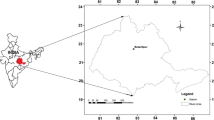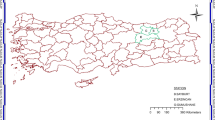Abstract
The protection of high quality fresh water in times of global climate changes is of tremendous importance since it is the key factor of local demographic and economic development. One such fresh water source is Vrana Lake, located on the completely karstified Island of Cres in Croatia. Over the last few decades a severe and dangerous decrease of the lake level has been documented. In order to develop a reliable lake level prediction, the application of the artificial neural networks (ANN) was used for the first time. The paper proposes time-series forecasting models based on the monthly measurements of the lake level during the last 38 years, capable to predict 6 or 12 months ahead. In order to gain the best possible model performance, the forecasting models were built using two types of ANN: the Long-Short Term Memory (LSTM) recurrent neural network (RNN), and the feed forward neural network (FFNN). Instead of classic lagged data set, the proposed models were trained with the set of sequences with different length created from the time series data. The models were trained with the same set of the training parameters in order to establish the same conditions for the performance analysis. Based on root mean squared error (RMSE) and correlation coefficient (R) the performance analysis shown that both model types can achieve satisfactory results. The analysis also revealed that regardless of the model types, they outperform classic ANN models based on datasets with fixed number of features and one month the prediction period. Analysis also revealed that the proposed models outperform classic time series forecasting models based on ARIMA and other similar methods .








Similar content being viewed by others
References
Altunkaynak A (2007) Forecasting surface water level fluctuations of lake Van by artificial neural networks. Water Resour Manag 21(2):399–408
Abdel-Hamid O, Mohamed A, Jiang H, Deng L, Penn G, Yu D (2014) Convolutional neural networks for speech recognition. IEEE/ACM Transactions on Audio, Speech, and Language Processing 22(10):1533–1545. https://doi.org/10.1109/TASLP.2014.2339736
Akbari Asanjan A, Yang T, Hsu K, Sorooshian S, Lin J, Peng Q (2018) Short–term precipitation forecast based on the PERSIANN system and LSTM recurrent neural networks. J Geophys Res-Atmos 123(22):12,543-12,563. https://doi.org/10.1029/2018JD028375
Bonacci O (2017) Preliminary analysis of the decrease in water level of Vrana Lake on the small carbonate island of Cres (Dinaric karst, Croatia). Geological Society, London, Special Publications, 466. https://doi.org/10.1144/SP466.6
Cao Q, Ewing BT, Thompson MA (2012) Forecasting wind speed with recurrent neural networks. Eur J Oper Res 221(1):148–154. https://doi.org/10.1016/j.ejor.2012.02.042
Chang F-J, et al. (2014) Real-time multi-step-ahead water level forecasting by recurrent neural networks for urban flood control. J Hydrol 517:836–46
Cantón R, Gibaja M, Romero DE, Caballero Morales SO (2018) Sales prediction through neural networks for a small dataset, International Journal of Interactive Multimedia and Artificial Intelligence, https://doi.org/10.9781/ijimai.2018.04.003
Crapper PF, Fleming PM, Kalma JD (1996) Prediction of lake levels using water balance models. Environ Softw 11(4):251–258. https://doi.org/10.1016/S0266-9838(96)00018-4
Danandeh Mehr A, Kahya E, Sahin A, Nazemosadat MJ (2015) Successive-station monthly streamflow prediction using different ANN algorithms. Int J Environ Sci Technol 12(7):2191–2200
Donahue J, Hendricks LA, Rohrbach M, Venugopalan S, Guadarrama S, Saenko K, Darrell T (2017) Long-term recurrent convolutional networks for visual recognition and description. IEEE Trans Pattern Anal Mach Intell 39(4):677–691. https://doi.org/10.1109/TPAMI.2016.2599174
Ghorbani A, et al. (2010) Mohammad sea water level forecasting using genetic programming and comparing the performance with artificial neural networks. Comput Geosci 36(5):620–27
Ghorbani MA, Deo RC, Yaseen ZM, Kashani H, Mohammadi M, Pan B (2017) Evaporation prediction using a hybrid multilayer perceptron-firefly algorithm (MLP-FFA) model: case study in North Iran. Theor Appl Climatol :1–13. https://doi.org/10.1007/s00704-017-2244-0
Gong Y, Zhang Y, Lan S, Wang H (2016) A comparative study of artificial neural networks, support vector machines and adaptive neuro fuzzy inference system for forecasting groundwater levels near lake Okeechobee, Florida. Water Resour Manag 30 (1):375–391. https://doi.org/10.1007/s11269-015-1167-8
Hochreiter S, Schmidhuber J (1997) Long short-term memory. Neural Comput 9(8):1735–1780. https://doi.org/10.1162/neco.1997.9.8.1735
Hrnjica B (2018) ANNdotNET- deep learning on .NET platform, Zenodo, https://doi.org/10.5281/zenodo.1461722
Kratzert F, Klotz D, Brenner C, Schulz K, Herrnegger M (2018) Rainfall–runoff modelling using Long Short-Term Memory (LSTM) networks. Hydrol Earth Syst Sci. https://doi.org/10.5194/hess-22-6005-2018
Lee TL (2008) Back-propagation neural network for the prediction of the short-term storm surge in Taichung Harbor, Taiwan. Eng Appl Artif Intell 21(1):63–72. https://doi.org/10.1016/j.engappai.2007.03.002
Lukman QA, Ruslan FA, Adnan R (2017) 5 hours ahead of time flood water level prediction modelling using NNARX technique: case study terengganu. In: 2016 7th IEEE control and system graduate research colloquium, ICSGRC 2016 - Proceeding. https://doi.org/10.1109/ICSGRC.2016.7813310, pp 104–108
Mao J, Xu W, Yang Y, Wang J, Huang Z, Yuille A (2014) Deep captioning with multimodal recurrent neural networks (m-RNN). Retrieved from arXiv:1412.6632
Mehrotra K, Mohan CK, Ranka S (1997) Elements of artificial neural networks. Elements of Artificial Neural Networks
Modaresi F, Araghinejad S, Ebrahimi K (2018) A comparative assessment of artificial neural network, generalized regression neural network, least-square support vector regression, and K-nearest neighbor regression for monthly streamflow forecasting in linear and nonlinear conditions. Water Resour Manag 32(1):243–258
Nourani V, Danandeh Mehr A, Azad N (2018) Trend analysis of hydroclimatological variables in Urmia lake basin using hybrid wavelet Mann–Kendall and Sen tests. Environ Earth Sci 77:207. https://doi.org/10.1007/s12665-018-7390
Ondimu S, Murase H (2007) Reservoir level forecasting using neural networks: lake Naivasha. Biosyst Eng 96(1):135–138
Panapakidis IP, Dagoumas AS (2016) Day-ahead electricity price forecasting via the application of artificial neural network based models. Appl Energy. https://doi.org/10.1016/j.apenergy.2016.03.089
Piasecki A, Jurasz J, Skowron R (2017) Forecasting surface water level fluctuations of lake Serwy (Northeastern Poland) by artificial neural networks and multiple linear regression 2017. J Environ Eng Landsc Manag 25(4):379–388
Pineda FJ (1987) Generalization of back-propagation to recurrent neural networks. Phys Rev Lett 59(19):2229–2232. https://doi.org/10.1103/PhysRevLett.59.2229
Rani S, Parekh F (2014) Predicting reservoir water level using artificial neural network. International Journal of Innovative Research in Science Eng Technol 3 (7):14489–14496
Ren S, He K, Girshick R, Sun J (2017) Faster r-CNN: towards real-time object detection with region proposal networks. IEEE Transactions on Pattern Analysis and Machine Intelligence 39(6):1137–1149. https://doi.org/10.1109/TPAMI.2016.2577031
Rosenblatt F (1960) Perceptron simulation experiments. Proc IRE 48 (3):301–309. https://doi.org/10.1109/JRPROC.1960.287598
Sak H, Senior A, Beaufays F (2014) Long short-term memory recurrent neural network architectures for large scale acoustic modeling. Interspeech 2014 (September):338–342. arXiv:1402.1128
Seo Y, Kim S, Kisi O, Singh VP (2015) Daily water level forecasting using wavelet decomposition and artificial intelligence techniques. J Hydrol 520:224–43
Sethia A, Raut P (2019) Application of LSTM, GRU and ICA for stock price prediction. Springer, Singapore, pp 479–487
Sutskever I, Vinyals O, Le QV (2014) Sequence to sequence learning with neural networks. Adv Neural Inf Proces Syst (NIPS) :3104–3112. https://doi.org/10.1007/s10107-014-0839-0
Taylor SJ, Letham B (2018) Forecasting at scale. Am Stat. https://doi.org/10.1080/00031305.2017.1380080
Yu D, Eversole A, Seltzer M, Yao K, Kuchaiev O, Zhang Y, Huang X (2014) An introduction to computational networks and the computational network toolkit. Microsoft Res
Author information
Authors and Affiliations
Corresponding author
Additional information
Publisher’s Note
Springer Nature remains neutral with regard to jurisdictional claims in published maps and institutional affiliations.
Rights and permissions
About this article
Cite this article
Hrnjica, B., Bonacci, O. Lake Level Prediction using Feed Forward and Recurrent Neural Networks. Water Resour Manage 33, 2471–2484 (2019). https://doi.org/10.1007/s11269-019-02255-2
Received:
Accepted:
Published:
Issue Date:
DOI: https://doi.org/10.1007/s11269-019-02255-2




